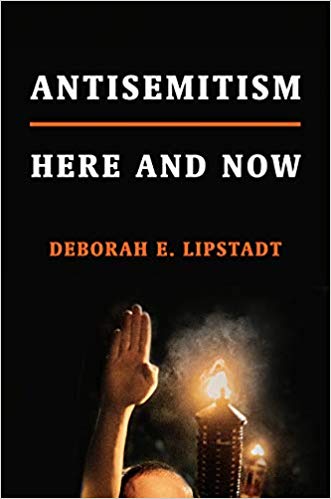Antisemitism
- By Deborah E. Lipstadt
- Schocken
- 304 pp.
- Reviewed by Helene Meyers
- February 29, 2020
How a pernicious evil persists even today.

Deborah E. Lipstadt’s Antisemitism: Here and Now was written after Charlottesville and before Pittsburgh. Since its release in late January, a spate of less-publicized but no less terrorizing attacks against identifiable Jews in Brooklyn has occurred, and a member of Congress has trafficked in antisemitism and apologized for it.
In other words, the timeliness of Lipstadt’s nuanced and accessible discussion of contemporary antisemitism cannot be overstated.
Antisemitism is structured as a series of letters between Lipstadt and two fictional interlocutors: Abigail, a Jewish senior at Emory University, where Lipstadt teaches, and Joe Wilson, a Gentile law professor who wants to be a knowledgeable and responsible friend to Jews. Although Abigail and Joe are Lipstadt’s creations, they function as “composites” of real people who have sought out Lipstadt to help them understand the dramatic rise of antisemitism in recent years.
Lipstadt’s dialogue with Abigail and Joe also represents an important part of her argument: Given that antisemitism is a persistent yet irrational conspiracy theory, “We must work to create firewalls between [the conspiracists] and those whom they might influence.”
While the extremists are beyond the pale of reason, Jews and their allies must arm themselves with knowledge and strategies to prevent the spread of this cultural cancer.
Lipstadt provides a useful taxonomy of antisemites. She notes that extremists are being normalized and mainstreamed not only by social media, but also by their own self-presentation as “ordinary Americans” who chant hate such as “Jews will not replace us,” but dress as if “they had just walked out of a J. Crew or Brooks Brothers catalog.”
Even more dangerous than these clean-cut neo-Nazis are those whom Lipstadt deems “antisemitic enablers,” a category that includes Donald Trump and Jeremy Corbyn. Rather than try to divine what is in the enabler’s heart, Lipstadt asks us to focus on how he amplifies and helps to institutionalize antisemitism.
The effect of the enabler is to embolden and enable hardcore antisemites, and she cites crowing from the editor of the Daily Stormer, a neo-Nazi website, and from the so-called “alt right” Richard Spencer to support this part of her argument.
Those who rationalize antisemitism are another version of the enabler. These folks offer “Yes, but” arguments, often weaponizing Israel as explanation or justification for violence against Jews. Insightfully, Lipstadt reads the attempt to equate Israeli actions with those of the Nazis as “Holocaust inversion,” which is a “form of soft-core Holocaust denial.”
On the question of the relationship between BDS (the Boycott, Divestment and Sanctions movement) and antisemitism, Lipstadt smartly answers, “It depends.” She distinguishes the original movement, with its end goal of the eradication of Israel as a Jewish state, from those BDS adherents who seek political strategies to end the occupation of the West Bank and to bring about a two-state solution.
However, she identifies the rhetorical sleight of hand of those who insist that they are anti-Zionist but refuse to acknowledge that the dismantling of a state already in existence is often the unspoken antisemitic goal.
For Lipstadt, responding to such disingenuous political posturing with anti-BDS laws that repress free speech neither serves democracy nor pro-Israel college students. Such ill-advised strategies are akin to the silencing — or attempted silencing — of Israeli speakers on campuses across the country. Here, as elsewhere, Lipstadt makes good on her promise to discomfit those on the left and the right.
Even those of us who have been keeping up with the dramatic and dismaying rise of antisemitism will find Lipstadt’s chronicle bracing. Trump and Corbyn as antisemitic enablers, as well as Charlottesville, are — or should be — on all of our minds, but do we know or remember that there was resistance to acknowledging that the 2015 terrorist attack at a kosher supermarket in Paris was motivated by antisemitism?
Do we know or remember that Mona Baker, a British academic, dismissed two Israeli academics from the advisory boards of the journals she oversees because of their national origin? Do we know or remember that progressive student organizations on college campuses will often not partner with Hillel on social-justice programming, even when those programs have nothing to do with Israel?
Do we know and remember that being a journalist while Jewish now often includes antisemitic trolling and death threats?
Lipstadt emphasizes that while we need to pay attention to this unanticipated resurgence of antisemitism, we should “not panic.” She does not want to short shrift the contemporary Jewish-American renaissance nor underestimate resistance to antisemitism. The story of the Emory University community donning blue to show support for a Jewish fraternity house that was vandalized with swastikas immediately after Yom Kippur is among the more heartening parts of this book.
And she concludes this important volume with the precious insight that Jews, like other groups that experience soul-battering oppression, must “balance the ‘oy’ with the ‘joy.’” Ultimately, she counsels the fictional Abigail — and, by, extension, Lipstadt’s real Jewish readers — to “never stop fighting the good fight, even as you rejoice in who you are.”
Antisemitism: Here and Now is a sobering but accessible read by an eminent scholar. In her acknowledgments, Lipstadt indicates that her agent urged her to write this book: “I demurred. He insisted. I am glad he did.” Jewish and Gentile readers concerned about antisemitism, democratic institutions, and academic freedom are likely to be glad, as well.
[Editor's note: This review originally ran in 2019.]
Helene Meyers is a professor of English at Southwestern University in Georgetown, TX. The author of Identity Papers: Contemporary Narratives of American Jewishness, Reading Michael Chabon, and Femicidal Fears: Narratives of the Female Gothic Experience, she has also written for Lilith, Ms. Blog, Tablet, the Chronicle of Higher Education, and numerous other publications.

